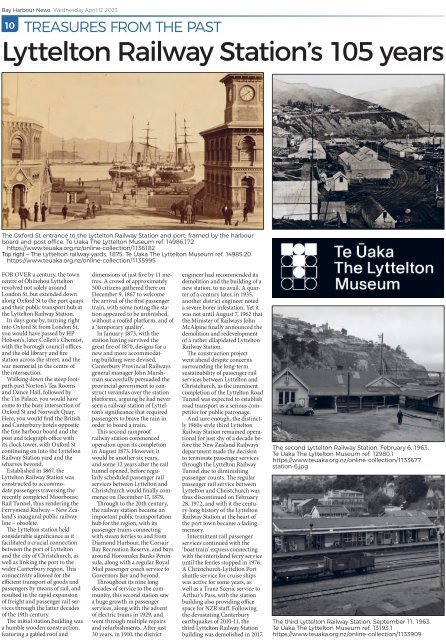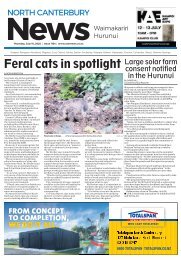Bay Harbour: April 12, 2023
Transform your PDFs into Flipbooks and boost your revenue!
Leverage SEO-optimized Flipbooks, powerful backlinks, and multimedia content to professionally showcase your products and significantly increase your reach.
<strong>Bay</strong> <strong>Harbour</strong> News Wednesday <strong>April</strong> <strong>12</strong> <strong>2023</strong><br />
10<br />
TREASURES FROM THE PAST<br />
Lyttelton Railway Station’s 105 years<br />
The Oxford St entrance to the Lyttelton Railway Station and port, framed by the harbour<br />
board and post office. Te Ūaka The Lyttelton Museum ref. 14986.172<br />
https://www.teuaka.org.nz/online-collection/1136182<br />
Top right – The Lyttelton railway yards, 1875. Te Ūaka The Lyttelton Museum ref. 14985.20<br />
https://www.teuaka.org.nz/online-collection/1135995<br />
FOR OVER a century, the town<br />
centre of Ōhinehou Lyttelton<br />
revolved not solely around<br />
London St, but extended down<br />
along Oxford St to the port quays<br />
and their public transport hub at<br />
the Lyttelton Railway Station.<br />
In days gone by, turning right<br />
into Oxford St from London St,<br />
you would have passed by HP<br />
Hobson’s, later Collett’s Chemist,<br />
with the borough council offices<br />
and the old library and fire<br />
station across the street, and the<br />
war memorial in the centre of<br />
the intersection.<br />
Walking down the steep footpath<br />
past Norton’s Tea Rooms<br />
and Dance Hall, followed by<br />
the Tin Palace, you would have<br />
come to the busy intersection of<br />
Oxford St and Norwich Quay.<br />
Here, you would find the British<br />
and Canterbury hotels opposite<br />
the fine harbour board and the<br />
post and telegraph office with<br />
its clock tower, with Oxford St<br />
continuing on into the Lyttelton<br />
Railway Station yard and the<br />
wharves beyond.<br />
Established in 1867, the<br />
Lyttelton Railway Station was<br />
constructed to accommodate<br />
passengers traversing the<br />
recently completed Moorhouse<br />
Rail Tunnel, thus rendering the<br />
Ferrymead Railway – New Zealand’s<br />
inaugural public railway<br />
line – obsolete.<br />
The Lyttelton station held<br />
considerable significance as it<br />
facilitated a crucial connection<br />
between the port of Lyttelton<br />
and the city of Christchurch, as<br />
well as linking the port to the<br />
wider Canterbury region. This<br />
connectivity allowed for the<br />
efficient transport of goods and<br />
passengers by means of rail, and<br />
resulted in the rapid expansion<br />
of freight and passenger rail services<br />
through the latter decades<br />
of the 19th century.<br />
The initial station building was<br />
a humble wooden construction,<br />
featuring a gabled roof and<br />
dimensions of just five by 11 metres.<br />
A crowd of approximately<br />
500 citizens gathered there on<br />
December 9, 1867 to welcome<br />
the arrival of the first passenger<br />
train, with some noting the station<br />
appeared to be unfinished,<br />
without a roofed platform, and of<br />
a ‘temporary quality’.<br />
In January 1873, with the<br />
station having survived the<br />
great fire of 1870, designs for a<br />
new and more accommodating<br />
building were devised.<br />
Canterbury Provincial Railways<br />
general manager John Marshman<br />
successfully persuaded the<br />
provincial government to construct<br />
verandas over the station<br />
platforms, arguing he had never<br />
seen a railway station of Lyttelton’s<br />
significance that required<br />
passengers to brave the rain in<br />
order to board a train.<br />
This second rainproof<br />
railway station commenced<br />
operation upon its completion<br />
in August 1873. However, it<br />
would be another six years,<br />
and some <strong>12</strong> years after the rail<br />
tunnel opened, before regularly<br />
scheduled passenger rail<br />
services between Lyttelton and<br />
Christchurch would finally commence<br />
on December 17, 1879.<br />
Through to the 20th century,<br />
the railway station became an<br />
important public transportation<br />
hub for the region, with its<br />
passenger trains connecting<br />
with steam ferries to and from<br />
Diamond <strong>Harbour</strong>, the Corsair<br />
<strong>Bay</strong> Recreation Reserve, and bays<br />
around Horomaka Banks Peninsula,<br />
along with a regular Royal<br />
Mail passenger coach service to<br />
Governors <strong>Bay</strong> and beyond.<br />
Throughout its nine long<br />
decades of service to the community,<br />
this second station saw<br />
a huge growth in passenger<br />
services, along with the advent<br />
of electric trains in 1929, and<br />
went through multiple repairs<br />
and refurbishments. After just<br />
30 years, in 1910, the district<br />
engineer had recommended its<br />
demolition and the building of a<br />
new station, to no avail. A quarter<br />
of a century later, in 1935,<br />
another district engineer noted<br />
a severe borer infestation. Yet it<br />
was not until August 7, 1962 that<br />
the Minister of Railways John<br />
McAlpine finally announced the<br />
demolition and redevelopment<br />
of a rather dilapidated Lyttelton<br />
Railway Station.<br />
The construction project<br />
went ahead despite concerns<br />
surrounding the long-term<br />
sustainability of passenger rail<br />
services between Lyttelton and<br />
Christchurch, as the imminent<br />
completion of the Lyttelton Road<br />
Tunnel was expected to establish<br />
road transport as a serious competitor<br />
for public patronage.<br />
And sure enough, the distinctly<br />
1960s-style third Lyttelton<br />
Railway Station remained operational<br />
for just shy of a decade before<br />
the New Zealand Railways<br />
department made the decision<br />
to terminate passenger services<br />
through the Lyttelton Railway<br />
Tunnel due to diminishing<br />
passenger counts. The regular<br />
passenger rail service between<br />
Lyttelton and Christchurch was<br />
thus discontinued on February<br />
28, 1972, and with it the century-long<br />
history of the Lyttelton<br />
Railway Station at the heart of<br />
the port town became a fading<br />
memory.<br />
Intermittent rail passenger<br />
services continued with the<br />
‘boat train’ express connecting<br />
with the interisland ferry service<br />
until the ferries stopped in 1976.<br />
A Christchurch-Lyttelton Port<br />
shuttle service for cruise ships<br />
was active for some years, as<br />
well as a Tranz Scenic service to<br />
Arthur’s Pass, with the station<br />
building also providing office<br />
space for NZR staff. Following<br />
the devastating Canterbury<br />
earthquakes of 2010-11, the<br />
third Lyttelton Railway Station<br />
building was demolished in 2017.<br />
The second Lyttelton Railway Station, February 6, 1963.<br />
Te Ūaka The Lyttelton Museum ref. <strong>12</strong>980.1<br />
https://www.teuaka.org.nz/online-collection/1133677<br />
station-6.jpg<br />
The third Lyttelton Railway Station, September 11, 1963.<br />
Te Ūaka The Lyttelton Museum ref. 13193.1<br />
https://www.teuaka.org.nz/online-collection/1133909


















